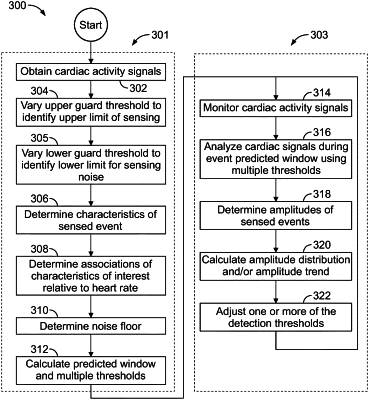| CPC A61B 5/366 (2021.01) [A61B 5/352 (2021.01); A61B 5/353 (2021.01); A61B 5/355 (2021.01); G16H 40/67 (2018.01)] | 18 Claims |

|
1. A computer implemented method for cardiac activity (CA) signals using an implantable medical device (IMD) that includes one or more processors, sensing circuitry, and sense electrodes coupled to the sensing circuitry to define first and second sensing channels, wherein under control of the one or more processors of the IMD that are configured with specific executable instructions, the method comprises:
detecting the CA signals, over the first and second channels, using the sense electrodes;
monitoring the CA signals detected by the sense electrodes, for a series of beats, over the first and second sensing channels having different first and second detection thresholds, respectively;
analyzing the CA signals over the first and second sensing channels utilizing the first and second detection thresholds, respectively, during an event prediction window to detect a presence of sensed events;
determining amplitudes of the sensed events detected;
determining whether the CA signals for a current beat of interest (BOI) exceed at least one of a primary detection threshold or an upper guard threshold, the upper guard threshold being greater than the primary detection threshold, wherein the first and second detection thresholds represent the primary detection threshold and the upper guard threshold, respectively;
calculating at least one of an amplitude distribution or amplitude trend for the sensed events detected over the first and second channels; and
adjusting at least one of the first or second detection thresholds based on the at least one of the amplitude distribution or amplitude trend.
|